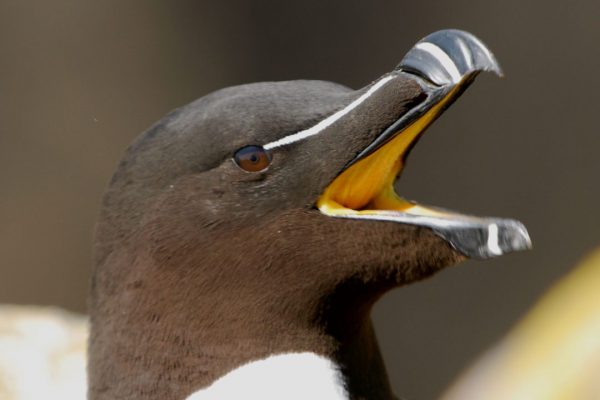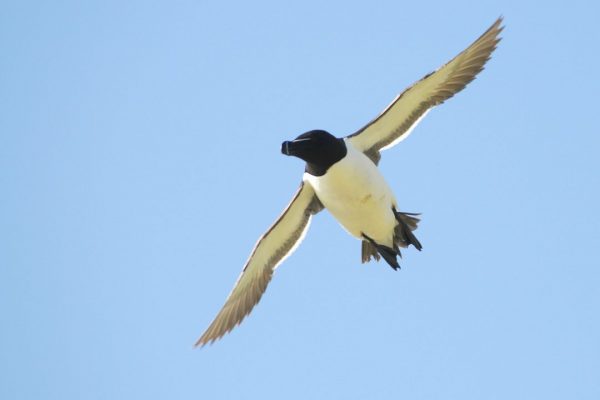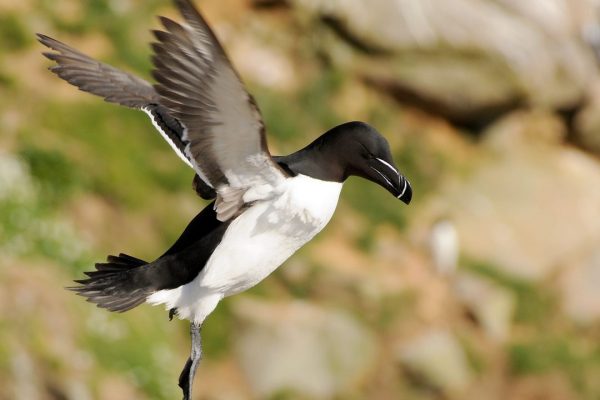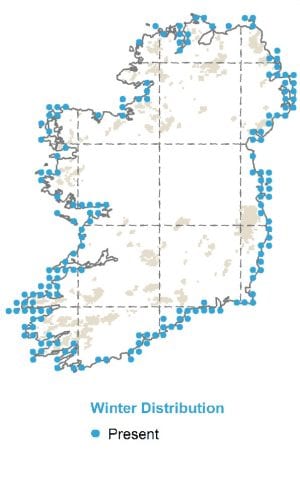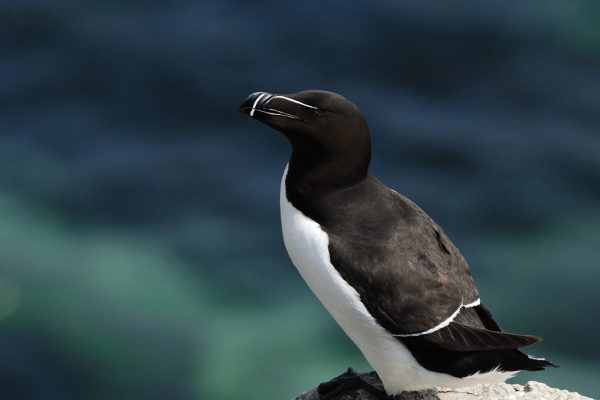
Razorbill
| Irish Name: | Crosán |
| Scientific name: | Alca torda |
| Bird Family: | Auks |
red
Conservation status
Conservation status
Status
Resident, though occur inshore/ land during the breeding season, March/April to August/September
Identification
A species of Auk, highly marine and only found on land in the breeding season. A black and white seabird, black above and white below, with a distinct breeding plumage. Head and neck all black in the breeding season with white on the front of the neck and face in the winter. Bill heavy, except in first winter birds. At a distance can be confused with Guillemot. Razorbill slightly smaller with blackish rather than brownish upperparts, more white on the side of the body and the bill distinctly heavier and blunter on adult birds. White 'armpit' compared to the darker 'armpit' of the Guillemot. Seen flying in lines close to the sea with Guillemots.
Voice
Similar to Guillemot but tone is harder.
Diet
Mainly small fish, some invertebrates, caught by surface diving.
Breeding
Nests on sea cliffs. Similar in habits to Guillemot with which it will breed in mixed colonies. Returns to colonies in March and April and departs by August. Will also use more secluded nest sites, fissures in the cliffs and also in screes, where it is more difficult to see, except when birds stand outside of their nest sites.
Wintering
Winters at sea.
Monitored by
Breeding seabirds are monitored through seabird surveys carried out every 15-20 years.
Blog posts about this bird
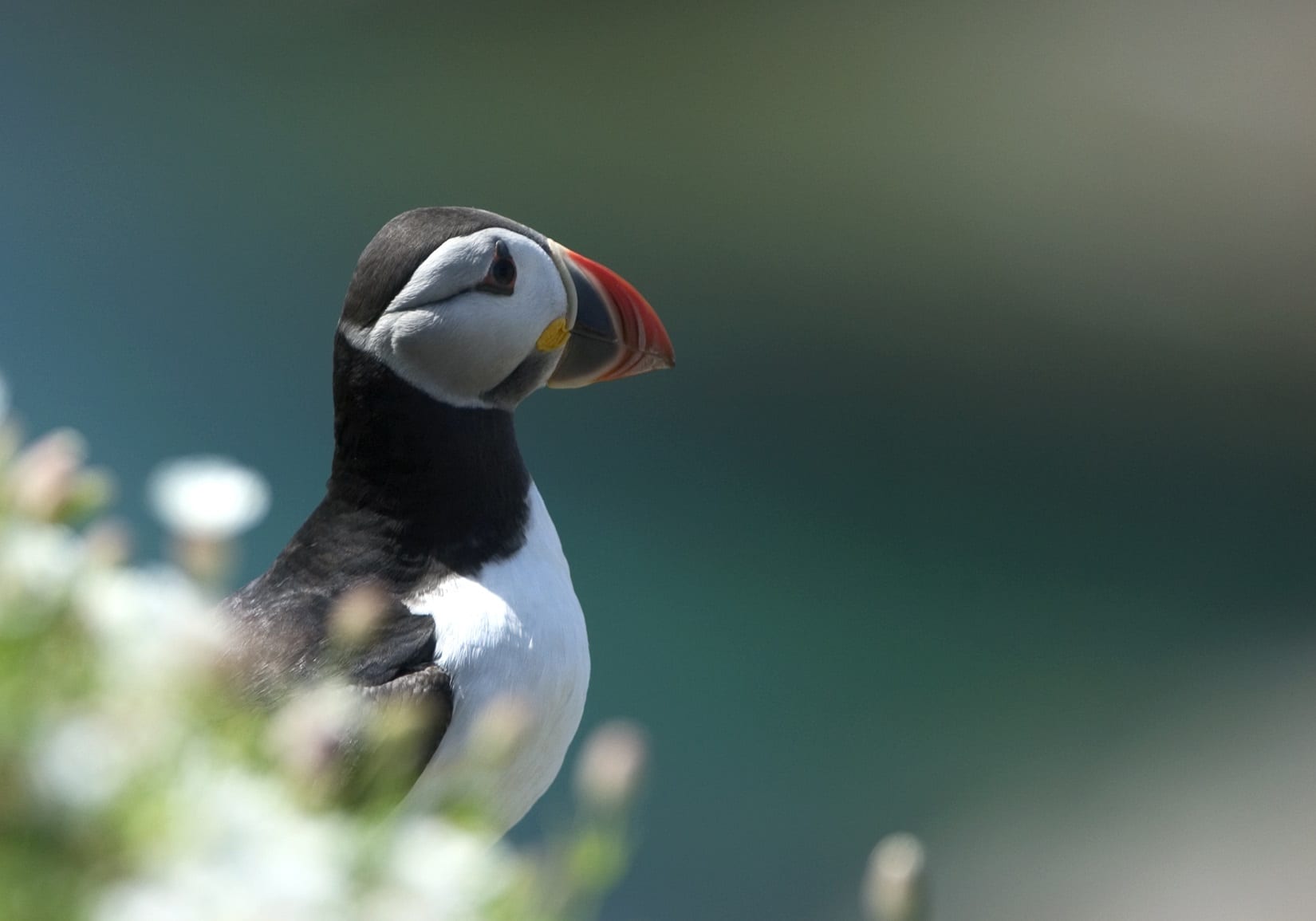
How you can take meaningful action this World Ocean Day
Saturday, June 8th marks World Ocean Day.
As an island nation, we have a strong physical and cultural connection to the sea. Indeed, the Fair Seas Ocean Literary Survey revealed that 99% of people feel marine protection is important to them, with 60% experiencing awe or wonder when they think about the marine environment. While this survey was the first of its kind in Ireland, the maritime traditions, art and literature of our ancestors would indicate that they felt much the same about our oceans.
However, today’s widespread interest and awe in the marine environment has an undercurrent of concern. We know from research that our marine environment and the life that depends on it is in trouble owing to pressures including climate change, pollution and overfishing. Oceana’s 2022 ‘On the Brink’ report highlighted the detrimental effect that overfishing has had on fish stocks in the Northeast Atlantic. Species like anchovy, eel, herring, horse mackerel, Norway lobster, sardine, and whiting, among others, have one or more stocks that are known or considered to be depleted. The most extreme case is that of cod, with nine depleted stocks – the highest number across the whole region.
For seabirds, healthy oceans provide a consistent food supply. When oceans are degraded and fish stocks depleted, it can have detrimental effects on seabird populations, adding to the many other pressures that these species are already facing. Of the 24 breeding seabirds in Ireland, 23 are Red- or Amber-listed Birds of Conservation Concern. Kittiwake, Puffin and Razorbill have joined the Red list having previously been Amber-listed, while the Kittiwake and Puffin are now classed as globally vulnerable.
We have cause for concern for other species, too. A recent report from Fair Seas and the Irish Whale and Dolphin Group (IWDG) highlighted the lower than expected numbers of Harbour Porpoise found in two Areas of Interest (the Southwest Coast and Loop Head to Kenmare River) surveyed, including in a Special Area of Conservation (SAC) designated for Harbour Porpoise. This decline is consistent with the findings of other recent surveys in three other SACs with this species as a qualifying factor.
However, all is not lost for, where there is curiosity and passion, there is hope. The theme of World Ocean Day in 2024 is "Catalyzing Action for Our Ocean and Climate". There is one fast but meaningful way you can take action to benefit the marine environment this World Ocean Day: Call on your Ministers to publish the MPA Bill.
There are many threats facing our oceans and, at present, government inaction is high on the list.
We know that many of the challenges facing the marine environment could be reduced with proper marine protection. However, it’s been nearly a year since the government promised to publish a Marine Protected Area (MPA) bill and, with just a handful of days left before the Dáil summer recess, this vital legislation still hasn't been introduced.
With less than one year left before the current government ends, the bill must be published urgently and moved effectively through the different stages of the Oireachtas in time if it is to have a chance of being passed at all.
Only One and Fair Seas are encouraging petition signers and Irish citizens to keep up the pressure and send letters to Minister Darragh O’Brien and Minister Malcolm Noonan directly, using our email tool, to urge for the swift publication of the MPA legislation. It only takes two clicks and several seconds to have your say. You can access this tool here: Write to Your Ministers: No Time to Waste to Protect Ireland’s Seas (only.one).

BirdWatch Ireland Nature Reserves to form part of Ireland’s first Marine National Park
BirdWatch Ireland is proud to partner with the National Parks and Wildlife Service (NPWS) and others in managing Ireland’s first Marine National Park – Páirc Náisiúnta na Mara, Ciarraí.
Announced on World Earth Day on Monday, April 22nd, the new National Park in Corca Dhuibhne, Co Kerry will unite some of Europe’s most ecologically valuable places across 70,000 acres of land and sea. These lands and waters provide extremely important nesting sites and food sources for seabirds including Red-listed species such as Puffin and Kittiwake and many other vulnerable Amber-listed species such as Manx Shearwater, Gannet and European Storm Petrel.
The Park will incorporate internationally important sites for seabirds such as BirdWatch Ireland managed Little Skellig and Puffin Island, as well as An Tiaracht Nature Reserve, which is managed by the Commissioners of Irish Lights.
It will also include new acquisitions by the National Parks and Wildlife Service (NPWS), such as the Conor Pass, the Owenmore River catchment, lands at Mount Brandon and the sand dune system at Inch Peninsula, along with sites already under State ownership, including the limestone reefs of Kerry Head Shoals and the waters around the Blasket Islands. The Páirc’s heritage legacy would be further enhanced by the inclusion of lands on the Great Blasket Island, the globally significant UNESCO World Heritage property of Sceilg Mhichíl, and Derrynane House, Historic Park and Beach, which are managed by the Office of Public Works (OPW).


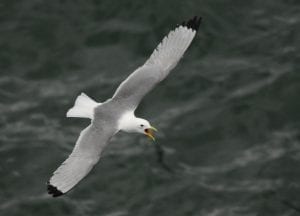
Kittiwake. Photo: John Fox.
Páirc Náisiúnta na Mara, Ciarraí was officially launched in Dingle on World Earth Day, with Jill Crosher from BirdWatch Ireland’s Corca Dhuibhne (West Kerry Gaeltacht) Branch serving as a proud local representative of BirdWatch Ireland at the event. In light of the announcement, CEO of BirdWatch Ireland Linda Lennon said: “We are delighted to announce our partnership on the new Páirc Náisiúnta na Mara, Ciarraí. This area, including BirdWatch Ireland’s Puffin Island and Little Skellig Nature Reserves, provides vital breeding and feeding sites to some of our most iconic and endangered seabirds. At BirdWatch Ireland, we are strong believers in the power of collaboration when it comes to making real change for our birds and wider biodiversity. We look forward to embarking on this new journey with our partners the NPWS, the OPW and the Commissioners of Irish Lights.” Speaking at the launch, Minister of State for Nature, Heritage and Electoral Reform, Malcolm Noonan said: “With the iconic Conor Pass as the gateway, Ireland’s first Marine National Park brings mountains, blanket bog, heaths, rivers, coastal dunes, limestone reefs, sea cliffs and some of the wildest land and seascapes in the country together in celebration of nature. Alongside its seven sister parks, Páírc Náisiúnta na Mara, Ciarraí will be a flagship for the protection and restoration of these incredible places and the globally important array of wildlife that they are home to. The Páirc will also honour the island and coastal communities who live alongside it by ensuring that their unique tapestry of cultural and natural heritage is central to the future story of this special place.” Niall Ó Donnchú, Director General of the National Parks and Wildlife Service said: “Our new park is a celebration of heritage in all its forms. Our biodiversity and natural heritage sit layered in harmony alongside monuments and historic wrecks from many periods. This is a place of iconic significance and majestic beauty. At times, shrouded in mist as a far outpost, ethereal in its past, evocative in its firing of the imagination, and vital in its biodiversity. Undoubtedly, a place of local pride and universal value. We look forward to working with our partners, the Office of Public Works, the National Monuments Service, the Commissioners for Irish Lights, Birdwatch Ireland, Kerry County Council and the local communities to realise a truly world-class National Park.”
Gannet. Photo: Gerry Kerr.
Established in 1983, Puffin Island Nature Reserve off the southwest tip of Kerry is a summer home to many cliff- and burrow-nesting birds. As its name suggests, the island hosts many Puffins, with thousands of pairs of this Red-listed Bird of Conservation Concern nesting there every summer. The island also holds one of the largest colonies of Manx Shearwater in the country, with large numbers of Storm Petrel also breeding here. Fulmar, Guillemot and Razorbill are some of the many other species for which this site is important. Owned and managed by BirdWatch Ireland, Puffin Island Nature Reserve is already a Special Area of Protection (SPA) under the European Birds Directive and an Important Bird Area (IBA) as identified by BirdLife International. The inclusion of the reserve in Páirc Náisiúnta na Mara adds another layer of protection to this vitally important site for birds. The Little Skellig Nature Reserve is an iconic BirdWatch Ireland nature reserve famed for its colony of some 35,000 pairs of Gannets – the largest breeding colony in Ireland and among the largest in the world. There are also smaller numbers of Guillemot, Puffin and Kittiwake present. Both Little Skellig and the adjacent Skellig Michael are protected by a Special Protection Area, designated under the European Union Birds Directive. These islands also form one of Ireland’s Important Bird Areas. While seabirds are highly dependent on Puffin Island and Little Skellig in order to breed, they also rely on the surrounding seas as a food source so it is vitally important that they receive protection. The announcement of Páirc Náisiúnta na Mara, Ciarraí is a step forward for seabirds, and the many other species that share these habitats with them.
